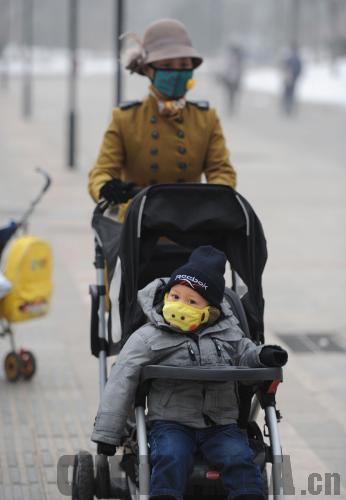|
 |
|
People wear face masks to combat air pollution LUO XIAOGUANG |
Vehicle emissions
On January 13, Beijing activated for the first time its emergency response program for hazardous air pollution. Outdoor sports activities for primary and middle schools were cancelled in areas worst hit by pollution. Construction was suspended in 28 sites and 54 businesses cut production to reduce their emissions. Thirty percent of government vehicles were taken off the roads.
To cut emissions, Beijing also plans to take 180,000 old vehicles off the road, and reduce coal consumption by 1.4 million tons. This will be done by upgrading coal-burning boilers and replacing heating systems in 44,000 homes with clean energy systems, as well as a greening program.
"Adjusting industrial and energy structures is a must," said Wang Jinnan, chief engineer with the Chinese Academy for Environmental Planning. "We need to move forward in the long and complicated process of PM2.5 treatment."
Auto emissions are generally considered to be the main culprit behind air pollution in Beijing. According to Hong Feng, Vice Mayor of Beijing, auto emissions accounted for 22 percent of the city's pollution. At the end of 2012, the city had more than 5 million vehicles on its streets. Commercial vehicles contributed disproportionately to pollution, being responsible for half of all vehicle emissions, due to the lagging emission standards.
On February 1, Beijing introduced stricter emission standards for motor vehicles. The new standards apply to new cars on the auto market and motor vehicles that have yet to receive license plates. According to Li Kunsheng, Director of the Vehicle Management Department, Beijing Municipal Environmental Protection Bureau, the new standard is on par with Europe and will decrease emissions by 40 percent.
But most cities in China still implement emission standards that allow 15 times more emissions than permitted in Beijing. The Ministry of Environmental Protection admitted that supplies of cleaner fuel aren't sufficient, causing new national tailpipe emission standards to be delayed.
"Major companies producing auto engines and commercial vehicles have technologically prepared for the new standards, but suitable oil can hardly be found on the market," said Yang Zaishun, expert on auto industry.
Fingers are increasingly pointed at the two largest oil refining companies in China - Sinopec and PetroChina, which have been criticized for not upgrading refineries due to high costs.
"China's petrochemical industry has dragged its feet when it comes to the country's environmental protection," said Fan Dayu, a commentator for Beijing Youth Daily. "The main reason is that large petrochemical enterprises are both market participants and makers of industry standards."
On February 1, Sinopec finally made a commitment under public pressure: oil adhering to new standards will be provided starting in 2014 to combat auto pollution.
Path of progress
The lingering veil of smog over Beijing has evoked many comparisons with the Great London Smog of 1952, which killed 12,000 people. In the following year, the Clean Air Act was passed in the UK to combat pollution by banning many pollution-emitting fuels and relocating power stations away from cities.
"Beijing suffers both from London's old problem (coal-fired power stations) and London's new pollution problem (traffic)," said Frank Kelly, a professor of environmental health at University of London's King's College. "To improve air quality, the Chinese authorities will need to tackle both of these problems."
Some analysts have noted that the UK's stage of economic development in 1952, as measured by its GDP per capita, was approximately the same as China's today.
"China is at the peak of its industrial pollution, as well as at the turning point of an environmental problem," said Dai Yixin, a professor at Tsinghua University's School of Public Policy and Management.
According to Dai, academic research has revealed that environmental destruction keeps increasing during the primary stage of a nation's economic development, but a turning point comes when per-capita GDP reaches $12,000. At that time, people's awareness of environmental protection rises as the economy develops, and they use technology or slow down development to improve environmental conditions. CA
|